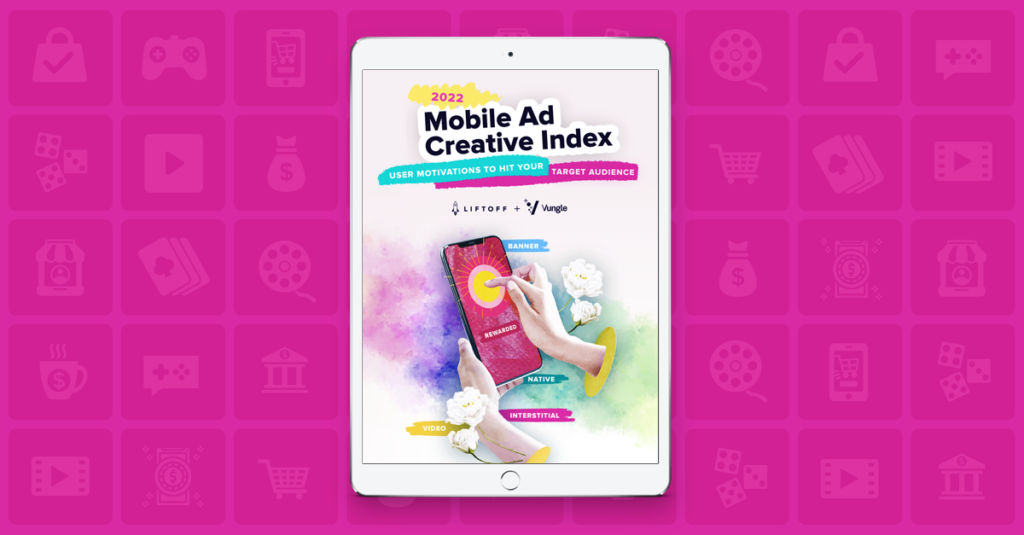
6 Ways to Wow Users With Your In-App Video Ad Creative
Natalie Suthons is the Motion Pod Lead at Liftoff. Read more from Natalie and other creative experts in Liftoff’s 2022 Mobile Creative Ad Index, where they share best ad practices for videos, playables, and more.
Video ads are a highly effective yet only increasingly popular form of advertising. According to eMarketer, video ad spending is expected to reach $81.05 billion in 2022—with most of the revenue coming from mobile. Across the board, mobile video ads can be one of the most versatile, engaging formats for attracting any audience. For mobile gaming especially, video ads can effectively drive advertisers’ revenue.
But how do you maximize the impact and reach of gaming video ads for your app? Since Apple’s iOS 14.5 began limiting granular targeting, creative is rapidly becoming an essential lever for boosting ad performance and reaching new audiences. And as with any campaign, building on winning creatives can make an outsized impact.
At Liftoff, we’re always looking for new ways to innovate. Beyond simple A/B testing for colors or video length, I recommend figuring out why something works and finding ways to innovate based on your analysis. In what follows, I outline six ways we build on existing best practices to improve performance and drive quality users to mobile gaming apps.
1. Appeal to emotions in gaming ads, and think about player motivations when you do.
The best-performing video ads tend to appeal to powerful emotions. Ads that feature big fail scenarios or dramatic roleplay can reel in users and boost engagement. But this is just the first step. Beyond triggering a reaction from users, ads that lead to conversions tap into why users might want to play a game. At Liftoff, we use GameRefinery to determine which player motivations to appeal to for any target audience. (You can also learn more about GameRefinery’s breakdown of player motivations here).
For instance, if we know that users prefer ads that showcase problem-solving—we might design ads that feature puzzles and players working out how to play. We combine this with an appeal to emotion—sometimes by giving a pause before a successful or failed move so that users can figure out how they would play the next move.
Another motivation that we have successfully tapped into is “competing against others.” For instance, in Match3 games, we experimented with adding a leaderboard at the end of the video—a player sees their name ascend the leaderboard. This way, users get a taste of the rewards of performing well over time against their friends.
2. Dig Into Why Fail or Success Scenarios in Video Ads Work
Typically, gaming video ads will show either success or fail scenarios. Success scenarios show players completing a level or unlocking a reward. Fail scenarios show players failing to complete a task. In the past year, we noticed that many ads featuring fail scenarios were performing a lot better than success scenarios.
As we dug deeper into the top performers, we found that it wasn’t that users preferred seeing someone fail or that the game seemed difficult, but that fail scenarios presented a surprise and a challenge. A move might seem silly or unexpected, and a player might think—“I can do better.” We were able to build on this insight and iterate on new winning ads.

3. Mastering Hybrid Formats: Adding Playables to Video Ads
It’s common for mobile gaming video ads to include a playable component. Playables offer players a sample of gameplay before they download—a kind of “play-before-you-buy” deal. If applied thoughtfully, hybrid formats–a video plus playable, for example–can increase engagement and drive conversions.
As with appeals to emotion, it’s essential to figure out why elements resonate with your audience. We try to match the format with the publisher. For example, players in a role-playing game might tap away when they see match-3 elements. Instead, we might combine a minigame or video of gameplay with videos of customs skins because that’s much more appealing to the audience.
4. Learning from Misleading Gaming Ads
One of the more popular trends we’ve seen is misleading ads. Instead of showing authentic gameplay, these ads will show scenarios or environments that players would never encounter in the actual game. We initially expected misleading video ads to be a passing fad, but many top-performing ads still feature elements that do not appear in the game itself.
Since misleading ads abuse user trust and can lead to greater churn, we propose an alternative. We try to find what makes them engaging, and we isolate and leverage what resonates in misleading ads while still showing a faithful representation of the game. For example, we’ve begun adding minigames and bonus levels that adhere closely to gameplay—they’ve worked so well that game developers have started inserting them into their games.
5. Finding an Ideal Video Length
Advertisers are always looking for the right video length—but it’s not a one-size-fits-all optimization method. Depending on the genre and mechanics of the game, you may find that a different ad format or length works better (you can learn more here).
That said, we have started introducing and experimenting with longer videos. Before, advertisers tended to prefer 30-second and 15-second videos. The assumption was that user attention was limited and that shorter forms would perform better. But in our experience, 45-second videos perform very well and are proven to be the most versatile.
6. Build Video Ads for Iteration, and Optimize
Finally, we always build videos for iteration. I recommend building modular elements into your video ads so they can be easily swapped out—either for testing or just to refresh the ad.
For example, we made a video ad for a casual gaming client with Halloween graphics. It became one of our top performers. Instead of starting fresh when the holiday ended, we swapped out Halloween for Christmas and then for Valentine’s and Easter. To save time and resources, build your video ads with easy alterations in mind.
Alternatively, you can even experiment with combining different winning video ads in hybrid formats. For instance, if you have an attractive fail scenario—it’s possible to combine the video with different minigames to land on what works best.
Remember that it’s not about having the best production value—or the biggest marketing team—but being smart about how you use your resources. The best-performing videos are not necessarily the ones that cost the most.

